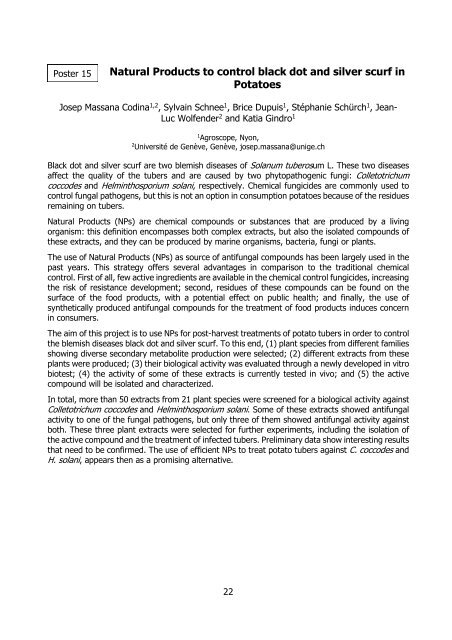sgp_info_2017_2
You also want an ePaper? Increase the reach of your titles
YUMPU automatically turns print PDFs into web optimized ePapers that Google loves.
Poster 15<br />
Natural Products to control black dot and silver scurf in<br />
Potatoes<br />
Josep Massana Codina 1,2 , Sylvain Schnee 1 , Brice Dupuis 1 , Stéphanie Schürch 1 , Jean-<br />
Luc Wolfender 2 and Katia Gindro 1<br />
1 Agroscope, Nyon,<br />
2 Université de Genève, Genève, josep.massana@unige.ch<br />
Black dot and silver scurf are two blemish diseases of Solanum tuberosum L. These two diseases<br />
affect the quality of the tubers and are caused by two phytopathogenic fungi: Colletotrichum<br />
coccodes and Helminthosporium solani, respectively. Chemical fungicides are commonly used to<br />
control fungal pathogens, but this is not an option in consumption potatoes because of the residues<br />
remaining on tubers.<br />
Natural Products (NPs) are chemical compounds or substances that are produced by a living<br />
organism: this definition encompasses both complex extracts, but also the isolated compounds of<br />
these extracts, and they can be produced by marine organisms, bacteria, fungi or plants.<br />
The use of Natural Products (NPs) as source of antifungal compounds has been largely used in the<br />
past years. This strategy offers several advantages in comparison to the traditional chemical<br />
control. First of all, few active ingredients are available in the chemical control fungicides, increasing<br />
the risk of resistance development; second, residues of these compounds can be found on the<br />
surface of the food products, with a potential effect on public health; and finally, the use of<br />
synthetically produced antifungal compounds for the treatment of food products induces concern<br />
in consumers.<br />
The aim of this project is to use NPs for post-harvest treatments of potato tubers in order to control<br />
the blemish diseases black dot and silver scurf. To this end, (1) plant species from different families<br />
showing diverse secondary metabolite production were selected; (2) different extracts from these<br />
plants were produced; (3) their biological activity was evaluated through a newly developed in vitro<br />
biotest; (4) the activity of some of these extracts is currently tested in vivo; and (5) the active<br />
compound will be isolated and characterized.<br />
In total, more than 50 extracts from 21 plant species were screened for a biological activity against<br />
Colletotrichum coccodes and Helminthosporium solani. Some of these extracts showed antifungal<br />
activity to one of the fungal pathogens, but only three of them showed antifungal activity against<br />
both. These three plant extracts were selected for further experiments, including the isolation of<br />
the active compound and the treatment of infected tubers. Preliminary data show interesting results<br />
that need to be confirmed. The use of efficient NPs to treat potato tubers against C. coccodes and<br />
H. solani, appears then as a promising alternative.<br />
22



